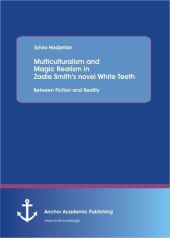 Neuerscheinungen 2014Stand: 2020-02-01 |
Schnellsuche
ISBN/Stichwort/Autor
|
Herderstraße 10
10625 Berlin
Tel.: 030 315 714 16
Fax 030 315 714 14
info@buchspektrum.de |

Sylvia Hadjetian
Multiculturalism and Magic Realism in Zadie Smith´s novel White Teeth: Between Fiction and Reality
Erstauflage. 2014. 128 S. 220 mm
Verlag/Jahr: ANCHOR ACADEMIC PUBLISHING 2014
ISBN: 3-9548924-2-1 (3954892421)
Neue ISBN: 978-3-9548924-2-6 (9783954892426)
Preis und Lieferzeit: Bitte klicken
Since the 1970s, there has been increasing concern with the impact of (post)colonialism on British identities and culture. White Teeth by Zadie Smith is the story of three families from three different cultural backgrounds, set mostly in multicultural London. The first part of this book provides an overview of the former British Empire, the Commonwealth and the history of Bangladesh, Jamaica and the Jews in England as relevant to White Teeth. Following this, the role of the (former) centre of London will be presented. Subsequently, definitions and postcolonial theories (Bhabha, Said etc.) shall be discussed.The focus of this book is on life in multicultural London. The main aspects analysed in these chapters deal with identity, the location where the novel is set and racism. A further aim of the book is a comparison between the fictional world of White Teeth and reality. One chapter is devoted to the question of magic realism and the novel´s position between two worlds.In a summary, the writer hopes to convince the readers of the fascination felt when reading the novel and when plunging into the buzzing streets of contemporary multicultural London.
Text Sample:
Chapter 2., Britain and Immigration:
Immigration to Britain is not a new phenomenon. The flow of ethnic groups, from which the present British population originates, has a long history. The country has seen waves of immigration of different ethnic groups for centuries. Invaders like the Anglo-Saxons and Normans successively populated the country as well as the Irish, for example, as a result of the famines in Ireland in the 19th century. This has to be kept in mind when talking about immigration to Britain and its population as it is composed today.
The success of the novel considered in this book cannot be understood without any knowledge of the history of immigration and certain ethnic minorities in Britain, especially since the end of World War II , as the themes dealt with in the book are closely interlinked with that period of British history. This chapter will give an overview of selected aspects of this phenomenon.
2.1 Britain and Colonialism:
Because of its period of colonial expansion, Britain has had, for several centuries, a tradition of immigration which is reflected nowadays in its multicultural population . But what happened during the period of colonialism for it to result in cultural pluralism in Britain?
Colonialism refers to the seizure of foreign territories by imperial powers like Britain. The inhabitants of these countries are either expelled or suppressed, the land populated with colonisers and the economy exploited. The political power of the colonisers expands to their colonies and the colonisers decide on political issues, the education system and culture. The traditions of the local people are often forbidden or alienated.
Britain expanded its territories and colonies overseas from the 16th century with a climax at the end of the 19th century . Independence began mainly after World War II when most British possessions were decolonised and then founded their own states . As a consequence, the Empire came to a complete end in the 1960s . But most of the former colonies now belong to the Third World and are members of the Commonwealth of Nations, a voluntary association of 49 independent states which has evolved from the former British Empire . Its aims are to aid these countries and to promote international understanding, mutual co-operation and consultation among governments and scientific co-operation . Although there are no obligations concerning the education systems in the former colonies, there is a common tradition of English being the language of instruction at school.


